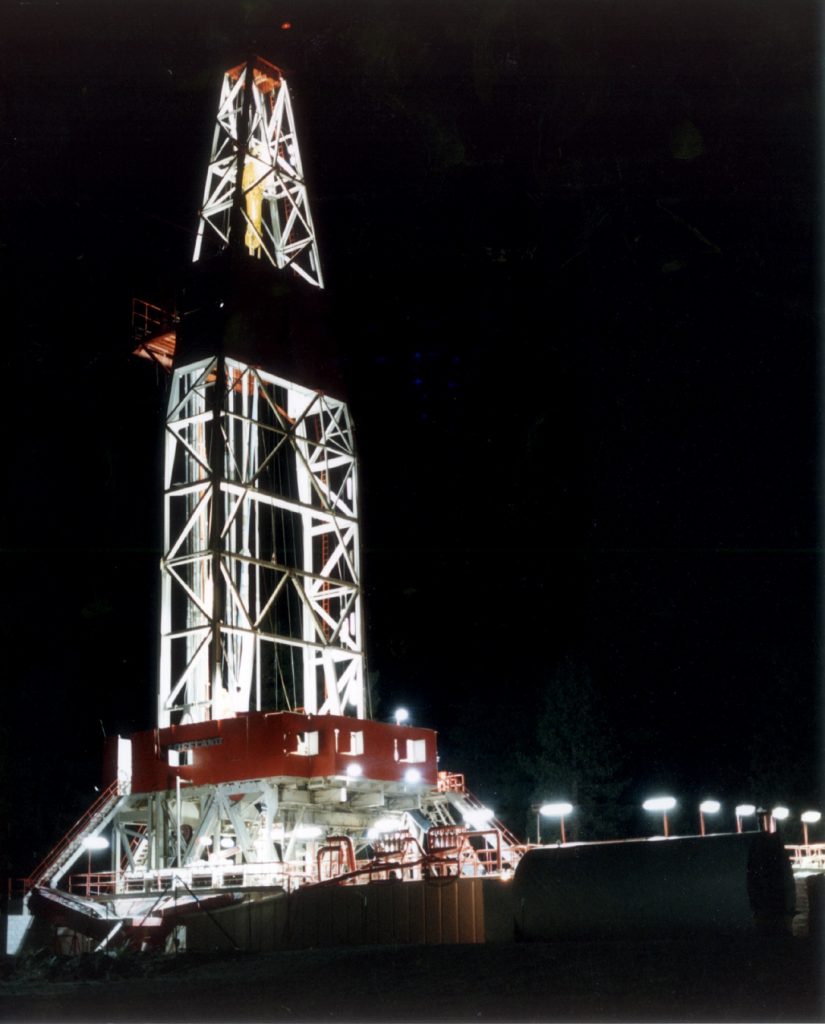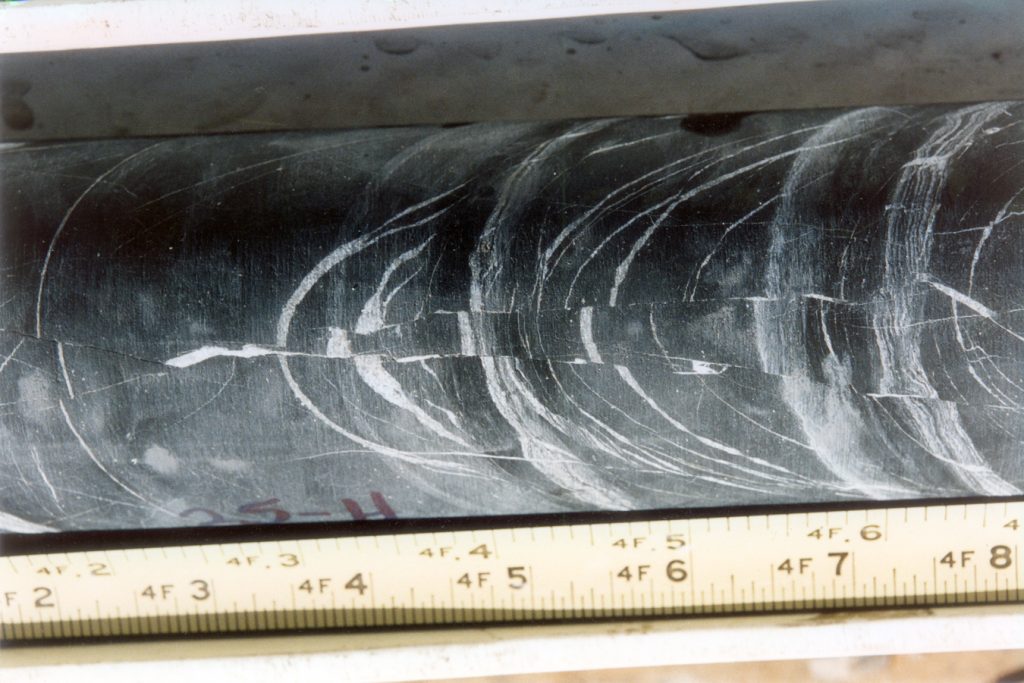
Download 150dpi JPEG image, ‘mammoth.jpg’, 540K
MAMMOTH LAKES, CALIF. — Resumed drilling at the Long Valley Exploratory Well near Mammoth Lakes, Calif., may provide new clues about local volcanic hazards and the role of underground magma in the energy future of California. The drilling operations are being led by a team from Sandia National Laboratories, a Department of Energy (DOE) national security lab.
“We are doing core drilling and expect to come away with some important scientific information about earthquake activity of the region as well as a determination of the potential use of magma heat energy for real applications such as generating electrical power,” says John Finger of Sandia’s Geothermal Research Department who serves as co-project manager with Ron Jacobson.
Drilling got underway at the well in July for the first time since 1991 in a third phase of the project. Work at the site was curtailed for the last several years due to lack of funding, but recent fund-raising efforts have given the project new life.
During this drilling stage, which is expected to extend through the end of September, researchers hope to determine exactly how deep the magma (molten rock) flows in the area. Once the magma location is pinpointed, the well could become an engineering laboratory for testing prototype systems and materials for heat exchange from magma.
The Long Valley Caldera is one of only three major volcanic calderas — craters formed after a volcano erupts — 10 miles or more in diameter in the US that are young enough to still contain magma close to the surface. Long Valley has had the most recent volcanic activity with the last eruption 550 years ago, and there is extensive geophysical evidence of magma’s presence.
Finger notes that this well project is one of very few research activities in the world drilling in a young caldera and studying the use of magma heat to generate electricity.
“Very hot wells have been drilled in Japan, Iceland, Indonesia, and other seismically active places, but, except for preliminary investigation by Shell International, no other work on magma is known to be underway,” he says. Four organizations — the California Energy Commission, US Geological Survey, DOE, and the International Continental Drilling Program (ICDP), based in Potsdam, Germany — have put together a $2 million funding package, which is allowing the drilling to resume.
The California Energy Commission, DOE, and Mono County, the county where Mammoth Lakes is located, want to learn more about the role the Long Valley Caldera can play in the energy future of the area. Three geothermal power plants several miles south of the well now produce about 40 megawatts of electrical power. If sufficiently high temperatures and permeable rock are found, the Long Valley dome could provide enough fluids for a fourth geothermal plant. And if high temperatures exist, but the rock is impermeable, the site could still be a candidate for electricity production, using a technique called hot-dry-rock. Sandia’s Geothermal Research Department will also have the opportunity to test several newly designed pieces of equipment in a realistic field environment.
Volcanic hazards posed by the caldera and neighboring Mammoth Mountain are of particular interest to the U.S. Geological Survey. The volcano first erupted 700,000 years ago with a major explosion, and it has remained active over the centuries. The current era of unrest began with an intense swarm of earthquakes, including four of magnitude 6, in 1980, and has continued at varying levels. During recent months earthquake activity has increased dramatically; the area experienced a 5.1 earthquake a few weeks ago. Also, the caldera’s dome has risen sporadically over the last 12 to 15 years. In fact, the area where the drill rig is located has risen three feet since 1986.

Download 150dpi JPEG image, ‘core.jpg’, 743K
This recent activity has captured the interest of the international earth science community, and hence the support of the ICDP. The drilling project will be tied to the ICDP’s Drilling Information system. Daily drilling reports, digital core images, and other scientific information will be regularly fed into the system during and after drilling and will be available on the Web.
Phase one of the project, drilling to a depth of 2,568 feet, started in 1989 as part of DOE’s Magma Energy Program. It was initially conceived as a magma energy well to be drilled in four phases to either a depth of 20,000 feet or a temperature of 500 degrees C, whichever came first. Although DOE canceled the program in 1990, the California Energy Commission remained interested in the magma concept and funded half of the second phase in 1991. DOE’s contribution to this effort, which drilled to 7,588 feet, was directed toward the advancement of conventional geothermal exploration.
In this third phase researchers hope to reach 11,500 feet — still a considerable distance from the top of the magma, which is believed to be somewhere between 18,000 to 26,000 feet. The closer approach is expected to result in a much better estimate of the magma’s depth.
The magma is physically close enough to reach using standard drilling methods, making it ideal for research. However, magma is not expected to be within drilling range in this third phase — that will be left up to a future project.
But, Finger says, when magma is reached, a heat exchanger could be inserted into it for long-term experiments. The heat exchanger, operating as a radiator in reverse, would use the magma to heat a liquid, which would then be pumped to the surface where the heat could be used for industrial processes or to generate electricity.
Jacobson notes that the third phase of drilling is different from the previous two.
“During phases one and two we employed drilling techniques found in oil well drilling, using a rotary drill that crushed rock. We did some core drilling at the end of each phase. This time we will drill a continuous core, which will be brought up to the surface for study,” Jacobson says.
And though the temperatures are expected to increase — possibly reaching as high as 350 degrees C, still considerably below the 900 degrees C temperature of magma — no “exotic” materials will be needed for the drill bits and other drilling equipment. The reason, Jacobson says, is that these temperatures are commonly reached in other geothermal drilling and even in deep oil and gas wells.
Throughout the drilling process, bottom-hole temperatures and pressures will be obtained with both instruments lowered from the surface and a data logger that rides in the core barrel. Depending on hole conditions, fluid samples may also be obtained. Upon completion, a steel liner will be left in place to allow a series of temperature logs over the next nine months.
During the summer of 1999 the well will be reconfigured as a downhole volcanological observatory for the US Geological Survey and other research institutions. The instruments to be used are still in the early design stages but will probably include seismometers to determine seismic activity and devices for monitoring water level, temperature, and strain.
Sandia is a multiprogram DOE laboratory, operated by a subsidiary of Lockheed Martin Corp. With main facilities in Albuquerque, N.M., and Livermore, Calif., Sandia has major research and development responsibilities in national security, energy, and environmental technologies and economic competitiveness.
Technical contact:
John Finger, jtfinge@sandia.gov, (505) 844-8089